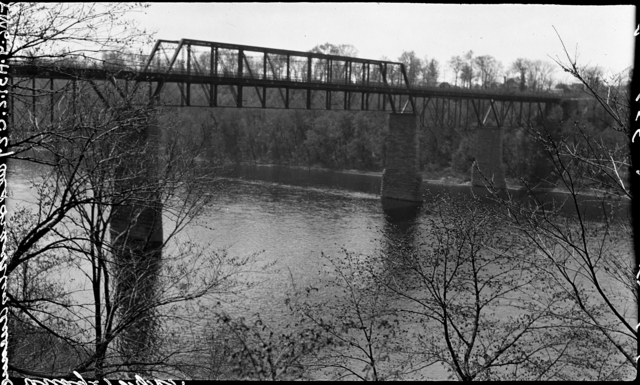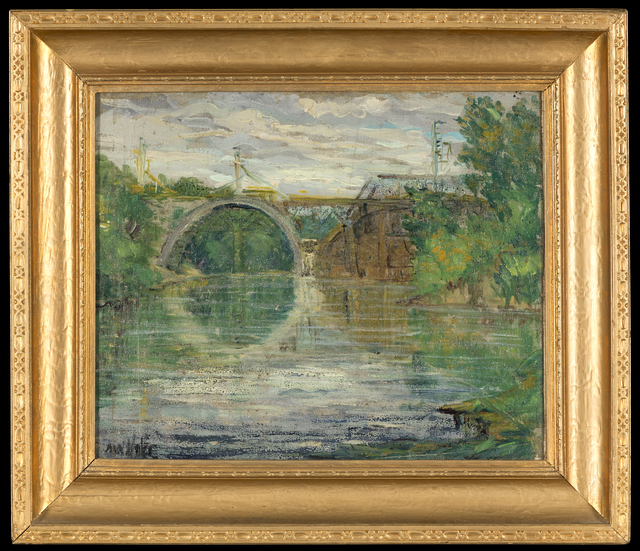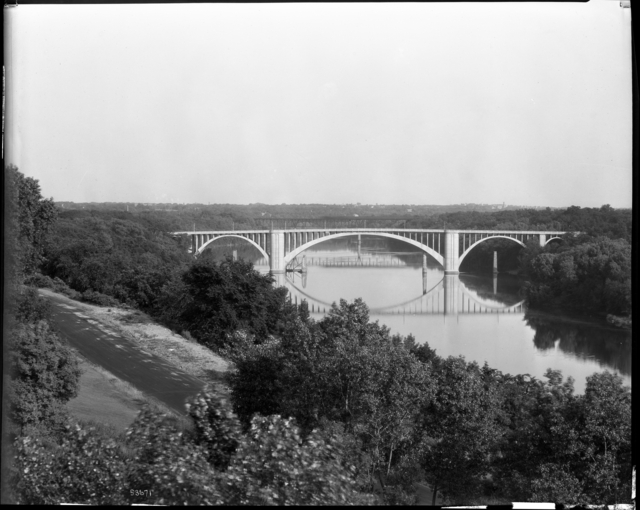The Longest Concrete Arch in the World
 Sunday, September 19, 2021 at 2:41AM |
Sunday, September 19, 2021 at 2:41AM |  Michael Rainville Jr |
Michael Rainville Jr | Article by Michael Rainville, Jr.
Minneapolis, the City of Lakes, but also, the City of Bridges. Dozens of bridges span the Mighty Mississippi, and each are famous for their own reasons. This week, I will tell the story of a bridge that once held the world record for the longest concrete arch in the world, the Franklin Avenue Bridge.
 The old Franklin Avenue bridge, 1912
The old Franklin Avenue bridge, 1912
Starting back in 1889, a metal bridge with stone piers was constructed where the current bridge stands. It served as a vital connected between Prospect Park on the east side and Seward on the west. Thirty years later, Minneapolis grew by nearly 350,000 people, and a larger bridge was needed. The two men tasked with designing a new bridge were Norwegians Kristoffer Olsen Oustad and Frederick William Cappelen, who lead the project. Cappelen designed the Prospect Park water tower, was previously Minneapolis’ municipal bridge engineer, and later was elected as the city engineer, with Oustad taking over as the municipal bridge engineer after Cappelen.
The advancements of concrete and steel in the early 1900s meant that much larger structures could be built than previously imagined, so Cappelen took this opportunity to give this new bridge a center span of at least 300 feet long and fifty feet tall. Over the course of the design process, Cappelen decided to lengthen the center span in order to keep the current bridge in operation until the new one could be completed. Construction started in 1919 and finished in 1923, with the center section spanning 435 feet across the river and providing eighty-eight feet of clearance for boat traffic. Upon completion, the center span was the largest concrete arch in the world.
 A 1920 painting of the construction of the current bridge by Ada Wolfe
A 1920 painting of the construction of the current bridge by Ada Wolfe
Unfortunately, Cappelen passed away in October of 1921, five days before his sixty-fourth birthday, so when the new bridge opened in 1923, it was officially named the F.W. Cappelen Memorial Bridge. During this era of bridge construction, similar bridges were constructed throughout the Twin Cities, and the area became known as having the best examples of concrete arch bridges in the world.
 1923 photo of the current bridge, looking downstream. Note the piers of the original bridge underneath the new bridge.
1923 photo of the current bridge, looking downstream. Note the piers of the original bridge underneath the new bridge.
In the 1940s, the streetcar tracks were removed from the bridge, and two more lanes of vehicle traffic were added, bringing the total number of lanes to four. Soon thereafter in 1954, West River Road was built underneath one of the arches. The bridge closed in 1971 for its first major renovation, and in 2005, a bike lane was added.
In 2007, an inspection revealed that freezing and unthawing water combined with salt from the winters contributed to significant corrosion. Efforts to repair the bridge began during the spring of 2015 after $28.5 million was set aside for the project the year before, and it was thought that the bridge would have to be closed for two years. However, the construction crew decided to use a method called Accelerated Bridge Construction in order to greatly speed up the process, and the bridge only had to be closed for five months.
Because of U.S. Bank Stadium construction driving up the price of concrete, the piers of the 1889 bridge were salvaged to help with costs, but the newly renovated bridge ended up having a price tag of $43 million. It includes two lanes of traffic with terrific, separated bike and pedestrian lanes, much needed improvements for one of the most bikeable cities in the nation. Because of the fantastic updates and renovation, the bridge and construction teams won the Engineering News-Record Midwest Award of Merit and the American Public Works Association Project of the Year Award in Historical Restoration/Preservation ($25 million to $75 million category), both in 2017.
The F.W. Cappelen Memorial Bridge, commonly referred to as the Franklin Avenue Bridge, is approaching its centennial birthday, and with the recent renovation, Minneapolitans will be able to enjoy this once record-holding bridge for another hundred years.
- - - - - - - - - - - - - - - - - - - - - - - - - - - - - - - - - - - - - - -
 About Michael Rainville, Jr.
About Michael Rainville, Jr.
A 6th generation Minneapolitan, Michael Rainville, Jr. received his B.A. in History, Graduate Certificate in Museum Studies, and M.A. in Art History from the University of St. Thomas.
